Pair of 18th Century George II Gothic Yew and Elm Windsor Armchairs, circa 1760
Sold
Request Information
Follow Us
Pair of 18th Century George II Gothic Yew and Elm Windsor Armchairs, circa 1760
The Windsor chair at its most elaborate and fine, the Gothic Windsor of yew wood and elm, circa 1760. England. It is, without doubt, the most sophisticated and elegant of all Windsor chairs and can be described as quintessentially English country furniture.
They are the most exquisite and fine design of all Windsor chairs and it is also the rarest of all models. This form is also known as the ‘Chippendale’ of country seating and ‘Strawberry Hill’ design, after the Strawberry Hill House in London was remodelled by Horace Walpole (1717-1797) and featured windows with a distinctive gothic shape.
A similar Windsor Chair is illustrated on the cover of ‘Windsor Chairs’ by Micheal Harding Hill, where he describes “This style of Windsor has been considered for some time to be the pinnacle of Windsor chair design; it is more sought after than any other Windsor chair, and it is rare than any of the other styles.”
Further reading:
Perhaps most famously, a notably similar set of six Gothic Windsor chairs belonging to Peggy and David Rockerfella, sold at Christie’s, New York in 2018 for, $336,500 (approximately £247,616), acquired from Mallet, London in 1995.
The Metropolitan Museum of Art, New York acquired a pair of Gothic Windsor armchairs in 2016 disclosing “Quintessentially English country furniture, this pair of Windsor armchairs (see also 2016.250) is a variant of the more traditional bow-back design. With its pointed arch-shaped back and openwork splats displaying Gothic tracery, these chairs beautifully reflect the Gothic taste which became fashionable in England in the middle of the 18th century.” Accession Number: 2016.234.
A similar chair, now in the Victoria and Albert Museum and illustrated in Anthony Coleridge, Chippendale Furniture, New York, 1968, pl. 157., is made from yew and mahogany. The period examples always incorporate yew, the prized timber for Windsor chairs. An identical yew chair with an elm seat is illustrated in The English Regional Chair and is attributed to London/Thames Valley (Bernard D. Cotton, The English Regional Chair, Suffolk, 1990, p.47, fig. TV22). Windsor chairs likely derived their name from the town of Windsor, a distribution centre of furniture made in the Thames Valley.
Another nearly identical chair is illustrated in Michael Harding-Hall, Windsor Chairs, London, 2003, p. 22, a pair of very similar chairs are illustrated in D. Knell, English Country Furniture, Suffolk, 2000, p. 327, pl. 83, while another single example sold from The Collection of Robert Hatfield Ellsworth, Christie’s, New York, 21 March 2015, lot 1159 ($43,750).
The English Regional Chair by Bernard D. Cotton.
Windsor Chairs by Michael Harding-Hill, Cover, Page: 22-23, 88, 85. an illustrated publication.
Condition
Good. Wear consistent with age and use.
Dimensions
Height: 40.56 in. (103 cm)
Width: 25.2 in. (64 cm)
Depth: 18.12 in. (46 cm)
Seat Height: 17.33 in. (44 cm)
PREVIOUSLY SOLD

A Fine 18th Century George II Mahogany Pie-Crust Tripod Table, Circa 1750
A Fine 18th Century George II Mahogany Pie-Crust Tripod Table, Circa 1750 Sold[wpforms_selector form_id="11387" show_title="on" _builder_version="4.22.1" _module_preset="default" custom_margin="-30px||||false|false" global_colors_info="{}"...
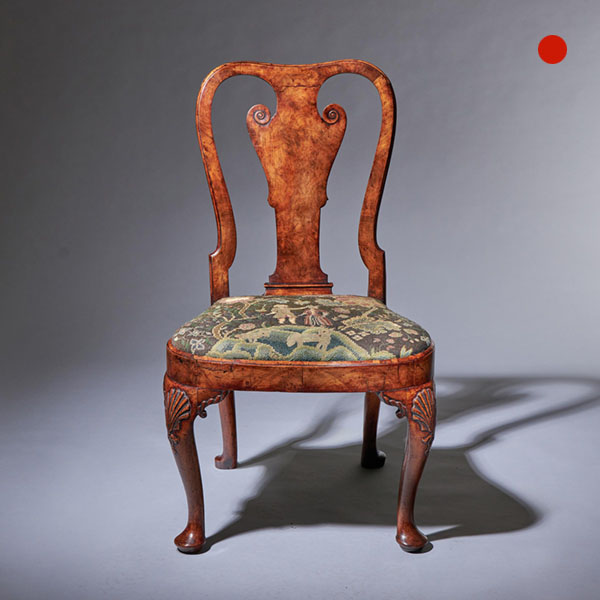
18th Century George I Carved Walnut Chair covered in Period Needlework
18th Century George I Carved Walnut Chair covered in Period Needlework SoldFollow Us18th Century George I Carved Walnut Chair covered in Period Needlework A superb early 18th-century George I carved walnut chair, circa 1720. England The...

William and Mary Olive Oyster 31” Table
An exceptional and extremely rare William and Mary Olive Oyster 31” Table, Circa 1670-1690. Inlaid with holly the moulded and banded top sits above a frieze drawer, beautifully raised on original freely carved Solomonic or twist legs, terminate on reverse pears and joined by ‘y’ shaped stretcher veneered in cross-grain olive.
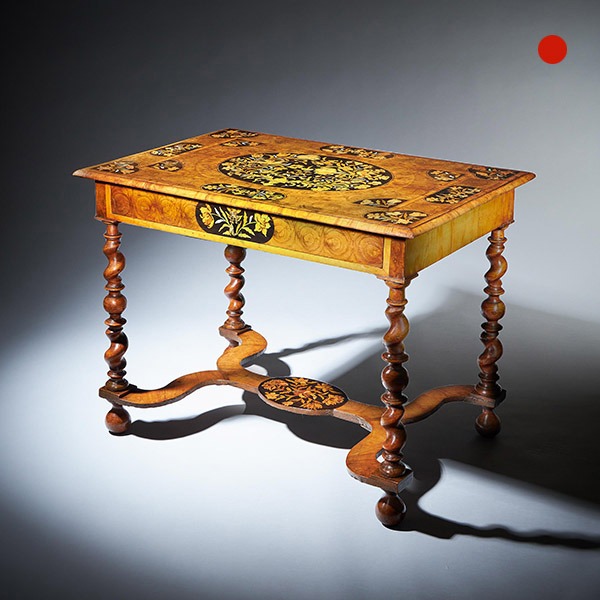
17th Century Charles II Olive Oyster Floral Marquetry Table, Circa 1680-1690
17th Century Charles II Olive Oyster Floral Marquetry Table, Circa 1680-1690 SoldFollow Us17th Century Charles II Olive Oyster Floral Marquetry Table, Circa 1680-1690 Floral marquetry inlaid olive oyster and ebony side table, attributed to...
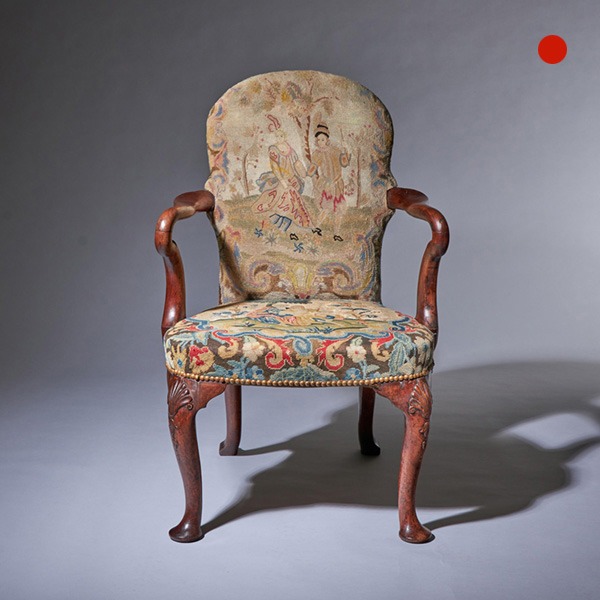
18th Century George I Walnut Shepherds Crook Arm Chair with Period Needlework
18th Century George I Walnut Shepherds Crook Arm Chair with Period Needlework Sold[wpforms_selector form_id="11387" show_title="on" _builder_version="4.22.1" _module_preset="default" custom_margin="-30px||||false|false"...
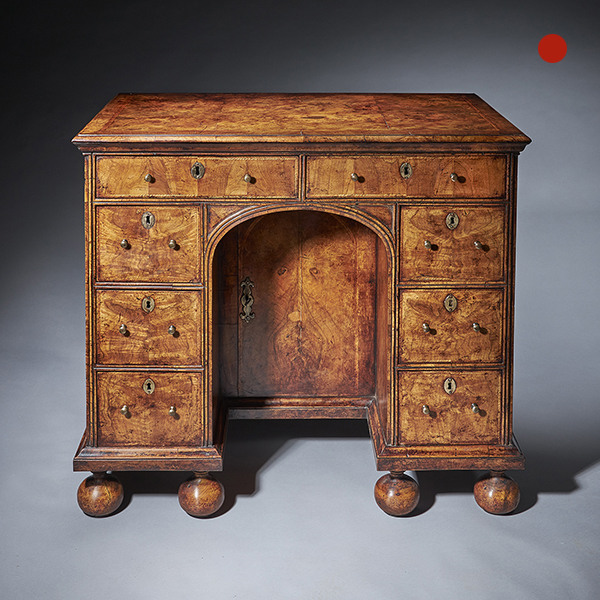
Queen Anne Walnut Kneehole Desk
The fine and rare Queen Anne (1702-1714) burr and highly figured walnut kneehole desk.
Above six solid walnut bun feet and cross-grain ogee moulding, six small drawers surround a double dee moulded edged kneehole under two long drawers

A Fine 18th Century George II Mahogany Pie-Crust Tripod Table, Circa 1750
A Fine 18th Century George II Mahogany Pie-Crust Tripod Table, Circa 1750 Sold[wpforms_selector form_id="11387" show_title="on" _builder_version="4.22.1" _module_preset="default" custom_margin="-30px||||false|false" global_colors_info="{}"...

18th Century George I Carved Walnut Chair covered in Period Needlework
18th Century George I Carved Walnut Chair covered in Period Needlework SoldFollow Us18th Century George I Carved Walnut Chair covered in Period Needlework A superb early 18th-century George I carved walnut chair, circa 1720. England The...

William and Mary Olive Oyster 31” Table
An exceptional and extremely rare William and Mary Olive Oyster 31” Table, Circa 1670-1690. Inlaid with holly the moulded and banded top sits above a frieze drawer, beautifully raised on original freely carved Solomonic or twist legs, terminate on reverse pears and joined by ‘y’ shaped stretcher veneered in cross-grain olive.

17th Century Charles II Olive Oyster Floral Marquetry Table, Circa 1680-1690
17th Century Charles II Olive Oyster Floral Marquetry Table, Circa 1680-1690 SoldFollow Us17th Century Charles II Olive Oyster Floral Marquetry Table, Circa 1680-1690 Floral marquetry inlaid olive oyster and ebony side table, attributed to...

18th Century George I Walnut Shepherds Crook Arm Chair with Period Needlework
18th Century George I Walnut Shepherds Crook Arm Chair with Period Needlework Sold[wpforms_selector form_id="11387" show_title="on" _builder_version="4.22.1" _module_preset="default" custom_margin="-30px||||false|false"...

Queen Anne Walnut Kneehole Desk
The fine and rare Queen Anne (1702-1714) burr and highly figured walnut kneehole desk.
Above six solid walnut bun feet and cross-grain ogee moulding, six small drawers surround a double dee moulded edged kneehole under two long drawers
YOU MAY ALSO LIKE

Highly Important 17th Century Charles II Floral Marquetry table by Gerrit Jensen
Highly Important 17th Century Charles II Floral Marquetry table by Gerrit Jensen £68,000Follow...

A 17th Century William and Mary eight-day double basket table clock by Asselin
A 17th Century William and Mary eight-day double basket table clock by Asselin £26,900Follow UsA...
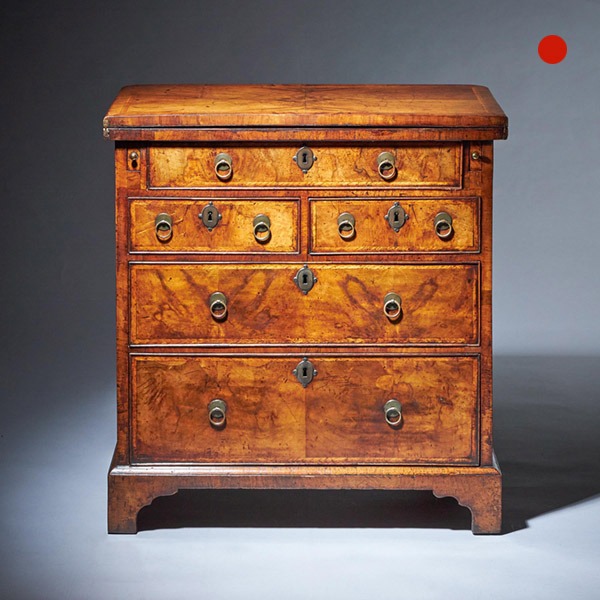
Early 18th Century George I Figured Walnut Bachelors Chest, C.1720-1730
Early 18th Century George I Figured Walnut Bachelors Chest, C.1720-1730 SoldFollow UsEarly 18th...

17th Century William and Mary Blond Olive Oyster Chest of drawers, Circa 1690
17th Century William and Mary Blond Olive Oyster Chest of drawers, Circa 1690 £15,000Follow Us17th...

A Fine Set of Six George III 18th Century Gothic Chippendale Dining Chairs, 1760
A Fine Set of Six George III 18th Century Gothic Chippendale Dining Chairs, 1760 £12,900Follow UsA...

A fine and extremely rare 17th century William and Mary baroque olive oyster chest on stand or ‘table box’, circa 1675-1690.
A fine and extremely rare 17th century William and Mary baroque olive oyster chest on stand or 'table box', circa 1675-1690. £12,600Follow UsA fine and extremely rare 17th century William and Mary baroque olive oyster chest on stand or 'table...

Highly Important 17th Century Charles II Floral Marquetry table by Gerrit Jensen
Highly Important 17th Century Charles II Floral Marquetry table by Gerrit Jensen £68,000Follow...

A 17th Century William and Mary eight-day double basket table clock by Asselin
A 17th Century William and Mary eight-day double basket table clock by Asselin £26,900Follow UsA...

Early 18th Century George I Figured Walnut Bachelors Chest, C.1720-1730
Early 18th Century George I Figured Walnut Bachelors Chest, C.1720-1730 SoldFollow UsEarly 18th...

17th Century William and Mary Blond Olive Oyster Chest of drawers, Circa 1690
17th Century William and Mary Blond Olive Oyster Chest of drawers, Circa 1690 £15,000Follow Us17th...

A Fine Set of Six George III 18th Century Gothic Chippendale Dining Chairs, 1760
A Fine Set of Six George III 18th Century Gothic Chippendale Dining Chairs, 1760 £12,900Follow UsA...

A fine and extremely rare 17th century William and Mary baroque olive oyster chest on stand or ‘table box’, circa 1675-1690.
A fine and extremely rare 17th century William and Mary baroque olive oyster chest on stand or 'table box', circa 1675-1690. £12,600Follow UsA fine and extremely rare 17th century William and Mary baroque olive oyster chest on stand or 'table...













